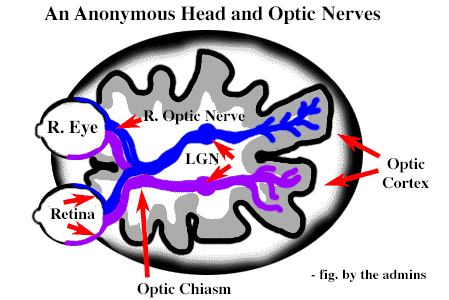
| MadSci Network: NeuroScience |
The human brain contains about 100,000,000,000 neurons.
You asked how many neural passages there are in the brain.
Neurons are comprised of a cell body which contains the nucleus and
gives rise to two types of processes- dendrites and axons.
Axons, which transmit information, can vary greatly in length
with some extending more than 1 meter.
Therefore, to answer your question, you could consider each neuron an
independent, neural passage. There are also large fiber tracts
(called white matter fiber tracts) within our brain that are
comprised of bundles of thousands of these axons.
These large axon fiber tracts connect various brain regions.
One large fiber tract in the brain is called the corpus callosum
which connects the right and left sides of the brain.
The second question asks about the anatomy of the visual system.
Why does the left eye hook to the right side of the brain, and the right
eye hook to the left side of the brain?
Your question is partially true.
It would help to understand the connections of the eyes to the brain
if you had a diagram in front of you.
The visual system is one of the most complex of all of the sensory systems.
The optic nerve (another white matter fiber tract) contains 1 million axons!!

Let me start with some basics of the visual system and perhaps that will clear up the matter for you. The area that you see in front of you is defined with respect to the retinas in each of your eyes. Each of your retinas is divided in half into left and right sections. Light from the right visual field falls onto the left half of each of your retinas and the light from the left visual field falls on the right half of each retina. The optic nerve comes out of the back of each retina containing information from that retina. The two optic nerves meet at the center of the brain at the optic chiasm. What happens from this point is that information from the left halves of each retina (containing information from the right visual field) come together and project to the left side of the brain and the information from the right halves (containing information from the left visual field) of each retina project to the right half of the brain. Therefore, each optic tract (as they are called after the optic chiasm) contains a complete representation of one half of your visual field. This scene can become much more complicated if you add in the center of your visual field but I will keep it simple. The optic tracts project to a region called the lateral geniculate nucleus. (LGN). Visual information processing is very complex and many hundreds of pages have been written on it. Basically, visual information (right and left visual fields) is parallel processed in three major pathways concerned (i) with movement, (ii) gross features, detail and form and (iii) thirdly color. The separation of the right and left visual fields is maintained as the projections of the visual information go to higher brain processing areas like the primary visual cortex located at the back of your head. So, you see now that it is not everything that the right eyes 'sees' or the left eye "sees" that goes to the opposite side of the brain. Eventually, the complete visual field (right and left) is put together in your brain to form the incredible vision containing depth, color and detail.
If you would like more details on the visual system (and there are many) and complex visual processing, I will refer you to an excellent text book called Principles of Neural Science written by Kandel, Schwartz and Jessell. The book contain several chapters on what is currently known about visual processing and contains some nice figures of the anatomy. It is standard in most medical libraries.
Try the links in the MadSci Library for more information on NeuroScience.